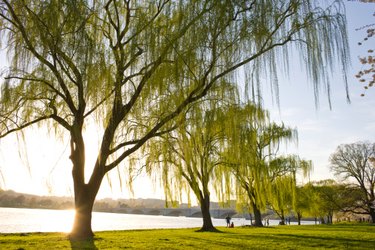
The words "willow tree" evokes a mental image of the weeping willow, with its leafy branches bending toward the ground like a flowing curtain. While the weeping willow is one of the most common species of willow, there are many other varieties, all sharing several things in common.
Taxonomy
Video of the Day
Willow trees are scientifically classified in the genus Salix, of the larger family Salicacae, which also encompasses poplar and aspen. Willows typically have narrow leaves, while their cousins, the poplar, have rounded leaves. There are approximately 400 distinct species of willow trees worldwide. Among the approximately 75 species found in North America, some of the more common varieties include weeping willow, pussy willow and black willow. All willows are woody, meaning they occur as trees or shrubs.
Video of the Day
Growth and propagation
Willow trees are flower producers, called angiosperms. Their flowers lack petals. They are simple, small and growing in narrow clusters called catkins. Specific trees produce either male or female flowers. Willows are typically fast growing and propagate by seeds produced through insect pollination or by tree cuttings. New trees have been known to take root and grow from willow branches that fell to the ground. Willows are frequently pioneer species, meaning that they are the first to inhabit a new area, or to repopulate an area after a scourging event such as fire.
Habitat
Willows prefer cool, moist soil. They are commonly found near streams, rivers, ponds, wetlands and floodplains. They occur in a wide range of climate zones, but are most common in the temperate zones of the Northern Hemisphere up to the arctic regions. Willows can occur farther north than any other angiosperm tree.
Usage
Willow wood is too soft for lumber usage, but the pulp is occasionally used for paper. The branches are frequently used for baskets and wickerwork. Historically, the bark of some willows have also been used for medicinal purposes as a predecessor to aspirin. Today, many willow varieties are used for ornamental landscaping. Additionally, willows are sometimes purposely planted along riverbanks for erosion control.